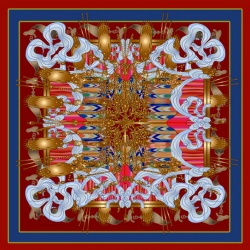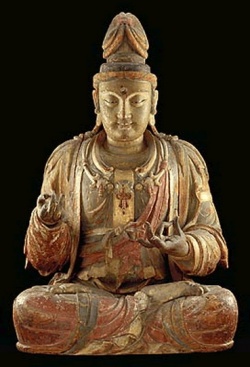Having Once Died and Returned to Life: Tibetan Biographies of the Journey Beyond Death
Introduction
The de-lok (das log) is a figure in the literature of Tibetan popular religion who dies (das), enters the intermediate bardo state, tours the netherworld, and returns (log) to report his or her afterlife experiences and to convey messages about the importance of moral conduct and religious commitment. Biographies of these individuals generally emphasize three points: the Buddhist principles of suffering and impermanence, the fluctuations of karma, and the means by which suffering can be eliminated. As such, the de-lok accounts are in accord with the basic teachings of Buddhism. Unlike the more formal texts included in the genres of Tibetan death literature, such as the Tibetan Book of the Dead, which are meant to be used primarily as guides for the deceased, recitations and readings of the de-lok biographies are aimed exclusively at a living lay audience. While parallels can be found between these popular texts and those of a more technical nature, the de-lok biographies rarely contain all of the details described in the advanced theoretical works. In addition, it is interesting to note that recent comparative and cross-cultural studies have demonstrated that the death-related events recounted in these Tibetan biographies are remarkably similar to the personal accounts of near-death experience (NDE) reported in the United States and Europe.
The After-Death Visions of Lama Jampa Delek
Tibetan: bLa ma byams pa bde legs kyis bar do dang bskal baâi gzigs snang dang chos kyi rgyal po phrin bsur rnams
Compiler: Don 'grub rdo rje In Three 'Das log Stories. Delhi: Don 'grub rdo rje, 1977. I-Tib-1742; 78- 900961.
Lama Jampa Delek's story begins in 1596 when, during meditative retreat, he is struck unexpectedly with a bizarre sickness. Feeling weak and emaciated, Lama Jampa loses the warmth in his body and begins to spit bloody phlegm. The doctors are called to administer medicine and perform the various curative rites, but to no avail. Several days later, we are told, Lama Jampa dies. It is here that the text begins to relate the many physical sensations and visonary experiences of the dying process in great detail. For example, as his body is deteriorating Lama Jampa grows increasingly sluggish and confused. Anxious and afraid, he withdraws into complete depression and cries out, "Please lift me up!," at which point he perceives a faint shimmering light like a translucent haze of heat rising from the earth. Later, he is met by a charismatic female figure who takes him on a tour of the bardo realm and convinces him to mend his sinful ways and to help others do the same.
Yoingza Chökyiâs Return from Death Tibetan: 'Das log gling bzaâ chos skyid kyi rnam thar
In Two Visionary Accounts of Returns from Death.
Delhi: Tibetan Bonpo Monastic Center, Dolanji, H.P., 1974. I-Tib 1305; 74-901396.
This sixteenth century tale of Lingza Chökyi's death experience is more representative of the majority of de-lok biographies. Feeling great stress and frustration over having been forced to neglect her religious aspirations and instead lead an ordinary woman's life as a wife and mother, Lingza Chökyi grows sick with fever. After being ill incurably for several weeks she has a claustophobic vision of being shoved underground and into a great ocean where she is tossed about wildly. She then experiences the heat of a scorching fire, hears loud roaring sounds, and sees various demons who laugh at and taunt her. Upon remembering the sobering instructions of her lama that all these visions, lights, and sounds are nothing more than projections of her own mind, Lingza Chökyiis hallucinations disappear and she returns to what seems to be her old room. However, when she looks over at her bed she sees to her dismay the putrid corpse of a large pig dressed in her clothes. She then notices that her husband and children and all of her friends are gathered around this horrible dead creature, wailing and crying. Each tear shed by a member of her family sends down a painful hail of pus and blood upon Lingza's head, and when the tears stop flowing, so does the bloody storm. After a while, her family and friends sit down to eat and, growing hungry, Lingza asks them for food and water, but they do not respond. Instead, her relatives place a bowl of food at the bedside next to the dead pig. Angered, Lingza Chökyi steps out of the room and hears a voice resembling that of her late father calling out, "Chökyi, come here! Follow me, I want to show you something." She leaves and, like Lama Jampa above, is led through the many levels of the bardo realm only to be later confronted by the Lord of Death, who narrates a long litany of her sins and virtues and then sends her back to preach the benefits of living a dutiful religious life..
The Story of Karma Wangzinâs Return from Death
Tibetan: 'Das log karma dbang 'dzin gyi rnam thar
Author: Khrag 'thun rdo rje Delhi, 1973. I-Tib-1141; 73-905481.
This mid-eighteenth century biography of Karma Wangzin is perhaps the most renowned and popular of the older Tibetan de-lok stories. Like Lingza Chökyi, Karma Wangzin was an intelligent, compassionate, and pious woman who wanted nothing more than to follow a devoted and virtuous Buddhist path. Her parents, on the other hand, had a different vision of the life they wanted their daughter to lead. An arrangement was set up with the governor of a neighboring district and Karma Wangzin was sent as his bride. One day in her room, the text relates, she has a vision of Padmasambhava, the eighth century yogin who had helped to establish Buddhism in Tibet. Reaching out to show her a skull-cup filled with nectar, Padmasambhava tells Karma Wangzin that this precious liquid will cure leprosy and bring joy to many suffering beings. A year later, she is stricken with a terrible disease and begins to have sensations usually associated with dying, such as the loss of feeling in her body, the inability to perceive external forms or hear sounds. As she regretfully recalls all the sins in her life, visions of the next life begin to appear and she is met by a woman dressed in white, who says "Get up! Do not suffer." The woman takes Karma Wangzin by the shoulder and pulls her along a path where she meets a late uncle who tells her to renounce all feelings of anger and jealousy. Longing for her family and friends, she calls out to them, but receives no reply. Instead, all that appears around her are unfamiliar faces contorted with fear, writhing in panic. Frantically she asks the woman in white, "Where are we? How can I get home?" The woman replies that they are in the bardo, in the City of the Dead, and that the visions appearing around her arise as frightful enemies only because of Karma Wangzin's ignorance and agitated emotional state. At that point, Karma Wangzin is lead through the City of the Dead where she witnesses many people being rewarded for their past virtues and punished for their sins. She meets some of them, listens to their solemn stories, and promises to take messages back to their families. Later, she meets the Lord of Death, who reviews all of her past rebirths and decides that she has accumulated enough merit to be granted temporary reprieve from the tortures of hell. Karma Wangzin returns to teach and to remind all whom she encounters that Buddhist doctrine is more than just philosophical mumbo jumbo and that devotion to religious practice is the only guarantee of a joyful destiny in the next life.
The Story of Latri Gyalwaâs Bardo Experience
Tibetan: dBra sprang lho gling smar khams gling gi bla mchod khri chen rgyal ba g.yung drung bstan 'dzin gyi 'khrul snang bar doâi rnam thar
Author: bLa khri rgyal ba g.yung drung (1814-1871) Ochghat, Distt. Solan, H.P., Tashi Dorji, 1985. I-Tib-2668; 85-902640.
This Bon-po account of the de-lok journey through the bardo, which follows closely many of the events related in our previous biographies, relates the story of Latri Gyalwa who, after losing the battle with a sudden and incurable illness, crosses the threshold of death and for several days moves freely through various otherworldy realms, often accompanied by a radiant female being. Frequently, Latri Gyalwa encounters marvelous people on his journey who recite verses from religious scriptures, such as those included in the Liberation upon Hearing. The message is always clear: respect one's teachers, practice their religious instruction, and avoid harming others.
Tibetan: dBu za rin chen sgron gsal gyis shi log dge sdig gsal byed 'phrul gyi me long
Compiler: sLob dpon bstan 'dzin rnam dag (b.1926)
In Three Bonpo Visionary Accounts of Hell. Delhi: Tibetan Bonpo Monastic Center, New Thobgyal, H.P., 1973. I-Tib-1034; 73-903236.
The Tale of Lhamo Lhamjungâs, Experiences in Hell
Tibetan: 'Das log lha mo lham gcung gi rnam thar dmyal ba 'grim paâi lo rgyus Author: Lha mo bu khrid
Darjeeling: Lama Dawa and Chopal Lama, 1984. I-Tib-2494
After a period of wandering in the bardo, the de-lok is usually led directly into the court of Dharmaraja, the Lord of Death. In the accounts here of Uza Rinchen Drönsel's and Lhama Lhamjung's meeting with this ominous magistrate, the experience is not unlike standing before an authoritative and all-knowing judge of a corrupt administrative bureaucracy. In the court of Dharmaraja, the de-lok witnesses a series of judgement trials in which the unjust pay dearly for their crimes and the just are not always set free. From here, the de-lok is taken to hell and back and then placed before the Judge. The two personal advocates (a white divine spirit and a black demon spirit) that are said to be born together with each individual--the "guardian angels," so to speak--join the de-lok to present their case. The Lord of Death listens attentively to their tale and orders a check of their statements in the "mirror of karma," in which is vividly reflected the de-lok's every virtuous and sinful act. When all is said and done, Dharmaraja pronounces judgement and exhorts the defendants to mend their ways. Curiously, in the case of Uza Rinchen and Lhama Lhamjung, the Lord of Death discovers that a simple bookkeeping error has been made concerning their proper identities and admits that they have more time left in this life after all. Upon their return, both men commit themselves to a life of religious service for the welfare of all suffering beings.
A Message from the Lord of Death
Tibetan: gShin rje chos kyi rgyal poâi gsung phrin
In Two Obscure Texts of the Avalokitesvara Cult from Spiti. New Delhi, O rgyan rdo rje, 1975. I-Tib-1447; 75-904456.
In this biography of the de-lok Longwa Adrung, recorded in 1533, the trial in the court of Dharmaraja ends with the Lord of Death presenting a lengthy injunction to moral conduct. In his message, Dharmaraja addresses the famous lamas of Tibet, meditation masters, Tantric yogins, religious scholars, nuns, government officials, laypeople, and beggars. Living beings, he warns, should work hard not to be led astray from the religious path due to laziness, hatred, or desire. They should not lust after the counterfeit joys of samsara or place lasting value on a world that is forever changing. Circumstances change, emotions change, and living beings trapped in the ceaseless cycle of birth and death continue to be swept along by the chaos of every moment. Practice diligently and resolve to generate compassionate concern for all suffering beings. The Lord of Death concludes his message with a prophecy concerning the fate of Longwa Adrung, who then suddenly finds himself in his body once more. In the usual case, a lama is asked to authenticate the de-lok's story in order to insure that a demon has not possessed the corpse and caused it to rise (ro-lang).





